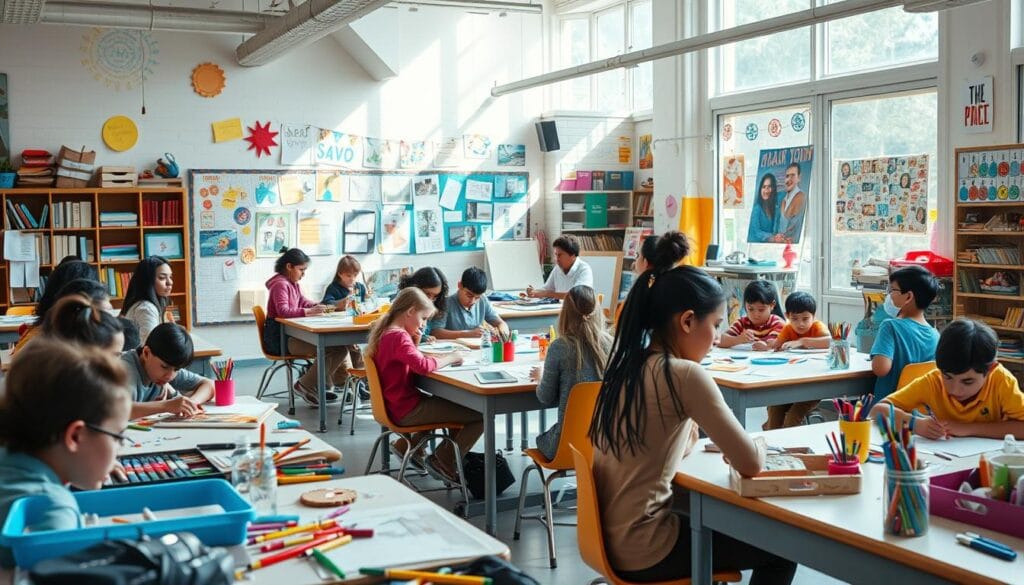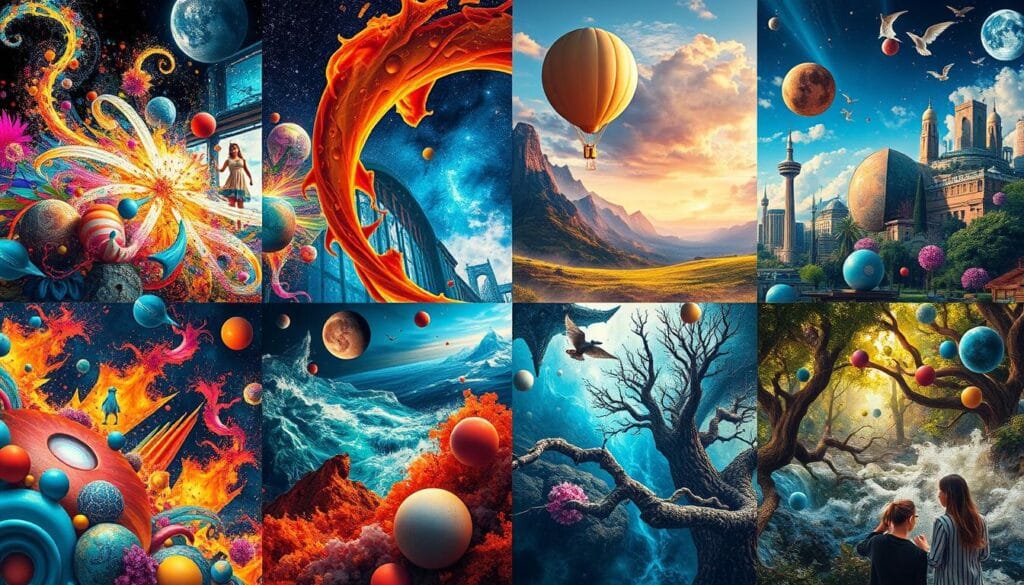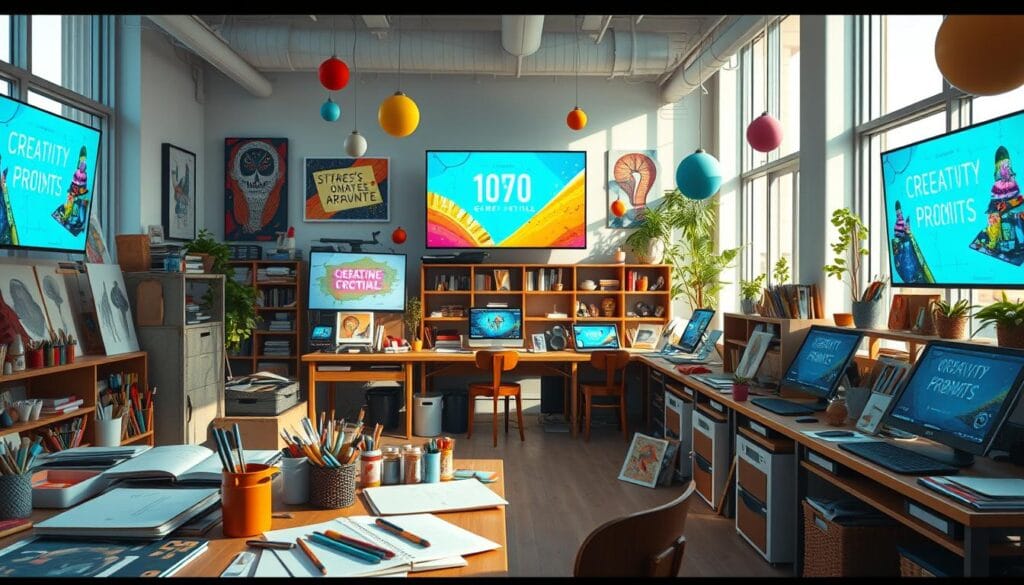“Imagination is the only weapon in the war against reality.” – Jules de Gaultier This profound statement highlights the essence of creativity and invites one to explore the boundless realm of imagination. In the world of writing and art, creative prompts serve as essential tools that ignite this imaginative spirit. They encourage self-expression, helping individuals overcome barriers and explore unique writing ideas. This article aims to delve into the various types of creative prompts, their significance, and how they can spark creativity in both writing and visual arts.
Creative prompts are not just simple ideas; they can serve as powerful catalysts for thought and innovation. For instance, there are 100 creative writing prompts designed specifically for middle and high school students. These prompts address themes from memories to abstract concepts, all intended to inspire diverse forms of writing like stories and poems1. Similarly, the world of visual art is enriched with 31 days of Art Prompt ideas that promote daily artistic practice. These ideas encourage artists to develop their skills and creativity2. These prompts can be tailored to various audiences, ensuring that writers and artists of all backgrounds can find inspiration to push their limits.
Key Takeaways
- Creative prompts serve as initiation points for overcoming creative blocks.
- There are various tools recommended for artists to enhance their creative process.
- Art prompts can facilitate the development of a daily creative habit.
- Creative writing prompts help students prepare assignments and college application essays.
- Flexibility in prompts allows for diverse interpretations, fostering unique ideas.
Understanding Creative Prompts
Creative prompts are essential for sparking imagination and guiding writers and artists. They offer a structure that aids in creative projects across various mediums, including writing and visual arts.
Definition and Purpose
At their core, creative prompts are statements or questions that prompt individuals to think outside the box and share their ideas. Their primary goal is to overcome writer’s block, stimulate brainstorming, and introduce new ideas. For example, prompts can delve into moral dilemmas, character relationships, and imaginative scenarios3. They also play a significant role in education, boosting students’ creativity and helping teachers assign homework3.
Importance in Writing and Art
The role of prompts in writing is vital. They encourage writers and artists to hone their skills and find their unique voice. By incorporating surprise, conflict, and moral reflection, prompts foster creativity in storytelling and character development3. The range of writing styles and themes available through prompts keeps students motivated and excited about their projects3. Moreover, peer feedback and support are crucial in refining prompts, highlighting the collaborative aspect of creativity4.
Types of Creative Prompts

Creative prompts fall into three main categories: writing, art, and brainstorming. Each type has its own role in boosting creativity and engaging with various artistic activities. Knowing the different types of creative prompts is key for sparking imagination and conveying ideas well.
Writing Prompts
Writing prompts aim to spark the writing process and challenge writers. With over 1800 unique ideas, writers can delve into genres like romance, thriller, and fantasy5. For those honing their craft, setting aside time for reflective writing is advised; some suggest ten minutes is enough6. These prompts are great for both experienced writers and newcomers, offering a supportive space to grow confidence and creativity.
Art Prompts
Art prompts inspire visual expression through themed projects or challenges. Artists can explore various techniques and motifs, laying the groundwork for artistic expression. Whether it’s painting, drawing, or mixed media, these prompts aim to boost creativity and challenge artistic limits.
Brainstorming Prompts
Brainstorming prompts help in generating ideas and fostering collaboration. They’re especially helpful in group settings, where participants can work together to come up with diverse ideas. By using structured prompts, groups can innovate and overcome creative hurdles, ensuring a fruitful creative session.
Creative Writing Prompts
Creative writing prompts are powerful tools for sparking imagination and starting the writing journey. They are particularly effective when matched to specific genres, offering genre-specific writing ideas that align with a writer’s creative goals. Each prompt can unlock new storytelling avenues, facilitating the exploration of diverse themes and conventions.
Genre-Specific Prompts
Genre-specific writing ideas are invaluable for writers aiming to delve into styles like science fiction, romance, or mystery. These prompts encourage the exploration of unique elements specific to each genre. This enhances the authenticity of the writing. By working with prompts designed for a chosen genre, writers gain a deeper understanding of narrative structures and character motivations.
Character Development Ideas
Character development prompts are essential for crafting engaging figures in stories. By engaging with character development prompts, writers can delve into characters’ backstories, relationships, and internal struggles. This not only enriches the characters but also enhances the overall narrative.
Plot Twists and Enhancements
Prompts that introduce unexpected plot twists are beneficial for writers. They challenge writers to think creatively about their storytelling methods. These twists can transform a simple story into something complex and captivating. By incorporating such prompts, writers keep readers engaged and refine their ability to craft suspenseful narratives.
Visual Art Prompts

Visual art prompts are crucial for artists aiming to boost their creative journey. They offer specific drawing challenges that prompt artists to venture beyond their comfort zones. With over 50 art prompt ideas, they serve as powerful tools for sparking creativity and overcoming creative hurdles7. Their adaptability makes them suitable for any medium or art form, appealing to a broad spectrum of artistic tastes7.
Drawing Challenges
Drawing challenges encompass a variety of themes and techniques, like drawing favorite foods or experimenting with materials like glitter. There are 30 unique drawing prompts available, designed to foster daily practice and consistency. These challenges cater to all skill levels, encouraging both novices and seasoned artists to explore new avenues of expression8.
Color Palette Inspirations
Color palette ideas for artists are pivotal in setting the mood and theme of any artwork. Art prompts that specify color combinations can inspire artists to venture beyond their typical choices. This leads to innovative and impactful pieces.
Themed Art Projects
Themed art projects offer a structured approach that enables artists to tell stories or convey messages through their work. Engaging with these visual art prompts can enhance narratives and broaden creativity. Incorporating art prompts into one’s practice is advised for artists seeking to challenge themselves and evolve in their craft7.
Prompts for Personal Growth
Prompts for personal growth are vital for self-reflection and introspective writing. They guide individuals to delve into their thoughts, emotions, and experiences. By documenting these reflections, one gains deeper insights into themselves and the world. Historical figures like Leonardo da Vinci and Frida Kahlo valued journaling for personal growth9. This practice aids in self-awareness, self-reflection, and aligning with personal goals, essential for personal growth.
Daily Journaling Ideas
Starting a daily journaling habit can greatly improve mental health and well-being. A study with 70 adults showed journaling for 15 minutes, three times a week, reduced mental distress and anxiety10. This daily routine helps understand one’s emotional landscape and identify thought and behavior patterns. Using prompts can deepen introspection and reflection, making journaling more effective.
For instance, prompts on personal identity, life goals, and relationships can significantly enhance a journaling routine.
Reflection and Self-Discovery Prompts
Reflection prompts for personal growth encourage individuals to critically examine significant life moments. Structured prompts help clarify thoughts and emotions, allowing for constructive feelings to emerge. Journaling can reframe negative thoughts, celebrate successes, and reduce stress, crucial for personal development at any age10.
With 57 inspiring personal growth journal prompts, structured reflections lay the groundwork for continuous growth. They help individuals understand their core values, strengths, and weaknesses9.
Creative Prompts for Educators

Creative prompts are vital for educators, boosting student engagement through diverse classroom activities. By using educational creative prompts, teachers can craft engaging classroom writing activities. These activities spark imagination and foster collaboration among students. They also provide a platform for students to freely express their ideas.
Classroom Activities
Integrating prompts into classroom activities encourages students to think critically and collaborate. For example, art and writing prompts allow students to explore different mediums. This helps them develop their talents in a structured setting. TeacherMade, a platform for educators, makes this easier by allowing them to incorporate AI-generated content into their materials11.
Group Projects and Collaborations
Group projects enhance teamwork and idea-sharing among students, crucial skills in education. Through collaborative projects, students engage in meaningful discussions, leading to deeper learning. In 2023, the ADE Institute highlighted AI tools and platforms for educational settings. This showed how technology can improve project collaboration12.
Digital Art and Design Prompts

The digital art world is growing fast, leading to many digital art prompts that spark creativity. These prompts often include design challenges for students, pushing them to improve their skills through specific tasks. These tasks are designed for various software, making use of AI art tools for quicker and more efficient creation.
Graphic Design Challenges
Graphic design challenges come in many forms, focusing on typography, layout, and color theory. These software-specific design tasks help students work with popular tools like Adobe Photoshop or Illustrator. By tackling themes like Abstract or Pop Culture, students can delve into different styles and techniques. This broadens their understanding of digital design.
Software-Specific Tasks
Software-specific tasks help designers apply their knowledge in a structured manner. For example, students might be asked to create a layout using a grid system in InDesign or to apply color theory in a digital painting with Procreate. These tasks enhance technical skills and encourage creativity, as students explore their software’s full potential. With 100% of digital art prompts suggesting personalization and AI tools like LimeWire’s AI Studio, artists are urged to customize their work and discover new creation methods131415.
Music and Sound Prompts

Music prompts are crucial for sparking creativity in musicians and songwriters. They span from specific lyric ideas to broader composition challenges. By exploring different themes, artists can tap into new emotional depths and expand their musical range.
Lyric Writing Prompts
Lyric writing prompts serve as a starting point for songwriting, offering a variety of themes. For example, they might focus on love, loss, or personal narratives. This allows writers to reflect on their experiences. There are 107 song prompts, with 8 each for love and break-up songs16.
Other prompts include relationship themes, storylines, and personal reflections. These embrace the unique facets of human experience16. Such prompts guide creativity toward deep lyrical insights, exploring a wide range of emotions.
Composition Challenges
Composition challenges invite musicians to experiment with their craft. They cover a wide range of themes, encouraging innovative approaches. This includes reverse writing and exploring various styles and genres17.
These challenges prompt artists to create catchy melodies or engaging grooves. They encourage venturing into new musical territories18. Notably, 90 song prompts focus on different emotional themes, offering a wealth of inspiration for creative growth18.
Collaborative Creative Prompts

Collaborative creative prompts are a powerful tool for boosting idea generation in groups. They create an environment where diverse perspectives can thrive. This leads to more innovative concepts and projects through group collaboration.
Group Brainstorming Techniques
Structured group brainstorming techniques can greatly enhance the creative process. Starting with collaborative prompts for creativity encourages participants to build on each other’s ideas. These methods highlight the value of open dialogue and inclusivity, allowing everyone to share their views freely.
Crowdsource Ideas
Crowdsourced idea generation is a modern approach to boost creativity. It involves community engagement through prompt-based challenges, like the Februllage challenge. This shows how artists can innovate together, leading to unique and diverse inspirations.
Incorporating prompts from various sources, such as AI, can further enrich the creative experience19.
Impromptu Creative Challenges

Impromptu creative challenges offer a unique space for spontaneous ideas and skill enhancement. The 30-day challenge for writers is a compelling format. It requires daily creation, pushing writers to explore various styles and themes. Each day brings a new task, sharpening their craft and introducing diverse creative exercises.
This consistent structure builds a creative habit. Over time, it significantly boosts creative output.
30-Day Prompt Challenge
Participating in a 30-day prompt challenge helps overcome creative blocks. It involves impromptu creative prompts that spark new ideas and expressions. This method not only boosts creativity but also builds a sense of achievement with each completed task.
As the challenge unfolds, the growth in skills becomes clear. It showcases the value of consistent practice.
Random Word Prompts
Random word creative exercises spark the imagination with unexpected concepts. They prompt individuals to venture beyond their comfort zones. By mixing unrelated words or themes, creators uncover new stories and artistic paths.
These prompts challenge participants to merge disparate ideas into cohesive solutions. This enriches their creative journey.
Using Technology for Prompts

Technology has revolutionized idea generation, merging imagination with innovation seamlessly. The advent of online prompt generators has streamlined access to creative prompts for writers and artists. These platforms employ sophisticated algorithms to offer unique, customizable prompts. This encourages users to delve into their creativity without bounds. Technology aids in generating new ideas swiftly, aiding those struggling with creative blocks.
Online Prompt Generators
Online writing generators are a game-changer in today’s fast-paced creative world. They provide targeted suggestions tailored to specific themes or genres, streamlining the creative process. A plethora of tools exists, each designed to spark and enhance the user’s writing journey. By incorporating detailed prompts that mirror the writer’s goals, these generators can produce more impactful and engaging content. Experts recommend including examples in prompts to elevate the quality of the output20. Thus, prompt engineering has become a vital skill for maximizing AI-driven tool benefits21.
Social Media Inspo
Social media is a treasure trove of creative inspiration, offering a wealth of art and writing to spark new ideas. Artists and writers can discover diverse perspectives and innovative projects through hashtags and themed pages. By incorporating elements found online, creators can infuse their work with unique styles and viewpoints. The act of sharing and discovering content across platforms builds a vibrant creative community. This makes it simpler to tap into social media creative inspiration whenever needed. Fine-tuning prompts to resonate with audience interests is crucial for achieving desired outcomes20
The Role of Imagination in Creativity

Imagination is the bedrock of creativity, showcasing the myriad ways people can share their unique views. With over 7 billion individuals worldwide, each with their own creative imagination, it’s clear that it’s a powerful tool22. To nurture an imaginative mind, one must engage in activities that spark creativity and encourage exploration. This includes diving into various art forms, practicing free writing or drawing, and working in creative environments22.
Cultivating an Imaginative Mindset
Methods to boost creativity include playing ‘what if’ games, visualization, and reading fiction22. The impact of colors on creativity is significant. Using vibrant colors can energize the creative process and foster an inspiring atmosphere23. Exploring different artistic styles and techniques can also unveil new aspects of one’s imagination, leading to innovative outputs23.
Overcoming Creative Blocks
Techniques to overcome writer’s block are crucial for keeping creative projects moving. Strategies like seeking inspiration from diverse cultural art forms and techniques that promote emotional expression can help23. Curiosity is key in sparking and using creative imagination, essential for personal growth and innovation22. The courage to venture into the unknown can lead to artistic breakthroughs, overcoming any creative hurdles.
Examples of Successful Creative Prompts

Successful writing prompts are crucial for creative processes in both writers and artists. Authors use specific prompts to explore themes and styles, enhancing their storytelling. For example, imagining life without basic necessities for a month prompts writers to think about survival and adaptation. Another prompt asks writers to create a menu for a fictional restaurant, blending culinary creativity with literary inspiration3.
Notable Writers and Their Prompts
Many authors benefit from engaging with prompts that spark their imagination. Prompts that encourage creating unique characters and exploring their motivations are particularly popular. Out of 25 creative writing prompts, five aim to evoke personal memories, and three focus on developing character narratives6. These prompts not only improve storytelling but also help authors connect their work to personal experiences.
Artists and Their Inspirations
Artists find inspiration in a wide range of sources, enriching their creative expressions. Creative writing prompts offer opportunities for artists to visualize scenes or emotions, covering diverse themes from romance to fantasy. The Reedsy Prompts page, for instance, offers over 1800 prompts, providing artists and writers with diverse inspiration5. These prompts contribute to vibrant cultural dialogues within the artistic community.
Adapting Prompts for Different Audiences

Adapting creative prompts demands careful thought about the audience. It’s essential to tailor prompts to match the developmental stages of different age groups. This ensures they are both fitting and stimulating. For instance, educators can use age-appropriate prompts that resonate with middle school students, as seen in “Writing Prompts For Middle School” in the literature24.
Such targeted prompts boost engagement and create a creative learning environment.
Tailoring to Age Groups
Recognizing the unique needs and interests of different age groups is crucial when adapting prompts. Younger audiences often enjoy prompts that spark imaginative storytelling. On the other hand, older individuals might prefer more complex challenges like “Drama Story Ideas” or “Flash Fiction Prompts”24.
Creating prompts that align with participants’ cognitive and emotional development can greatly impact their creativity.
Cultural Considerations
Cultural sensitivity in prompts is key to fostering inclusivity. By including themes and references from diverse backgrounds, creators can make prompts relatable and empowering for all. This approach enriches the creative process and underscores the value of representation in creative tasks25.
Prompts that reflect various cultural narratives can enhance creativity and celebrate diversity.
Conclusion on Creative Prompts
Creative prompts are essential for sparking imagination and advancing creative endeavors. They encourage individuals to journal, leading to personal growth and artistic refinement. Studies show journaling reduces stress and boosts mental health, making creative exploration highly beneficial26.
Encouragement to Explore Creativity
Regular engagement with diverse prompts can uncover new insights for artists at all levels. This practice enhances emotional and imaginative depth, guiding daily writing. Educators should integrate varied prompts into their teaching to foster exploration and creative thinking27.
Final Thoughts on Staying Inspired
Staying inspired requires consistent exposure to new ideas and stimuli. Creating a rich, creative environment is crucial. Commitment to the craft through perseverance and experimentation is key. By using brainstorming and reflection strategies, individuals can reach their creative potential and enjoy the journey of journaling jounal prompts.
FAQ
What are creative prompts?
Why are creative prompts important?
What types of creative prompts exist?
How can writing prompts enhance creativity?
What are some examples of visual art prompts?
How can prompts aid in personal growth?
How can educators use creative prompts?
What is the role of technology in creative prompts?
What are impromptu creative challenges?
How can creativity be cultivated?
Source Links
- 100 Creative Writing Prompts for Middle & High School – 2024
- 31 Art Prompt Ideas to exercise your creativity and boost your artistic mind | ArtPlacer
- 30 creative writing prompts to inspire you and your students
- A Guide to Crafting Effective Prompts for Diverse Applications
- 1800+ Creative Writing Prompts To Inspire You Right Now
- 25 Creative Writing Prompts | Lake Seminole Square
- 50 Art Prompt Ideas to Ignite Your Creativity and Fuel Your Artistic Passion
- 30 Creative Drawing Prompts | Gel Press
- 57 Deep Journal Prompts for Personal Growth & Self-Improvement – Sage & Bloom
- 100 Journal Prompts for Self-Discovery
- 50 ChatGPT prompts for teachers | TeacherMade
- One Best Thing – Prompt Crafting for Educators
- 30 Creative AI Art Prompts and Templates for Inspiration
- Top 25 AI Art Prompt Ideas to Spark Your Creativity
- 10 Best AI Art Prompts and Templates for Unleashing Creativity in 2024
- 107 Song Prompts for When You’re Really Stuck – The Song Foundry
- 30 Unique Songwriting Prompts to Craft Your Next Hit
- 270+ Song Prompts That Will Help You Create Viral Music | Musicfy AI Blog
- 55 Creative Prompts to Inspire Your Imagination
- Getting started with prompts for text-based Generative AI tools
- Effective Prompts for AI: The Essentials – MIT Sloan Teaching & Learning Technologies
- How To Unleash Your Creative Imagination
- Unleashing Imagination: 100s of Midjourney Prompts for Creative Exploration
- 122+ ‘Audience’ Writing Prompts
- Prompt Engineering: A beginner’s guide to Audience Prompts
- 50 Inspiring Journal Prompts to Spark Your Creativity
- Types of Prompts: Informational, Creative, Analytical







